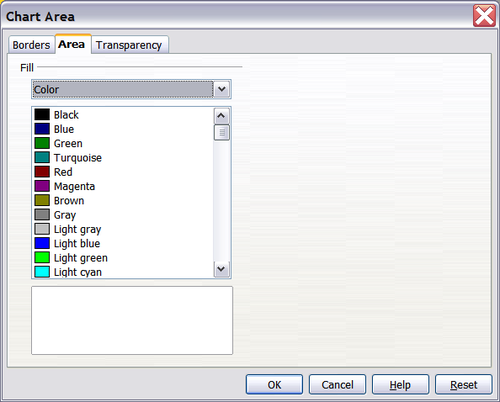Formatting charts
The Format menu has many options for formatting and fine-tuning the appearance of your charts.
Double-click the chart so that it is enclosed by a gray border indicating edit mode; then, select the chart element that you want to format. Choose Format from the menu bar, or right-click to display a pop-up (context) menu relevant to the selected element. The formatting choices are as follows.
Format Selection
- Opens a dialog in which you can specify the area fill, borders, transparency, characters, font effects, and other attributes of the selected element of the chart.
Position and Size
- Opens a dialog. See this page.
Arrangement
- Provides two choices: Bring Forward and Send Backward, of which only one may be active for some items. Use these choices to arrange overlapping data series.
Title
- Formats the titles of the chart and its axes.
Legend
- Formats the location, borders, background, and type of the legend.
Axis
- Formats the lines that create the chart as well as the font of the text that appears on both the X and Y axes.
Grid
- Formats the lines that create a grid for the chart.
Chart Wall, Chart Floor, Chart Area
- Described in the following sections.
Chart Type
- Changes what kind of chart is displayed and whether it is two- or three-dimensional.
Data Ranges
- Explained in this section and this section.
3D View
- Formats 3D charts.
| Chart Floor and 3D View are only available for a 3D chart. These options are unavailable (grayed out) if a 2D chart is selected. |
In most cases you need to select the exact element you want to format. Sometimes this can be tricky to do with the mouse, if the chart has many elements, especially if some of them are small or overlapping. If you have Tooltips turned on (in Tools > Options > OpenOffice.org > General > Help, select Tips), then as you move the mouse over each element, its name appears in the tooltip. Once you have selected one element, you can press Tab to move through the other elements until you find the one you want. The name of the selected element appears in the Status Bar.
Contents
Moving chart elements
You may wish to move or resize individual elements of a chart, independent of other chart elements. For example, you may wish to move the legend to a different place. Pie charts allow moving of individual wedges of the pie (in addition to the choice of “exploding” the entire pie).
- Double-click the chart so that is enclosed by a gray border.
- Click any of the elements—the title, the legend, or the chart graphic. Click and drag to move the element. If the element is already selected, then move the pointer over the element to get the move icon (small hand), then click, drag and move the element.
- Release the mouse button when the element is in the desired position.
| You can resize the chart graphic using its green resizing handles (Shift+Click, then drag a corner handle to maintain the proportions). However, you cannot resize the title or the key. |
Changing the chart area background
The chart area is the area surrounding the chart graphic, including the (optional) main title and key.
- Double-click the chart so that it is enclosed by a gray border.
- Select Format > Chart Area.
- On the Chart Area dialog, choose the desired format settings.
On the Area tab, you can change the color, or choose a hatch pattern, bitmap or some preset gradients. Click on the dropdown box to see the options. Patterns are probably more useful than color if you have to print out your chart in black and white.
You can also use the Transparency tab to change the area’s transparency. If you used a preset gradient from the Area tab, you can see the different parameters that made it.
Changing the chart graphic background
The chart wall is the area that contains the chart graphic.
- Double-click the chart so that it is enclosed by a gray border.
- Select Format > Chart Wall. The Chart Wall dialog has the same formatting options as described in Changing the chart area background above.
- Choose your settings and click OK.
Changing colors
If you need a different color scheme from the default for the charts in all your documents, go to Tools > Options > Charts > Colors, which has a much wider range of colors to choose from. Changes made in this dialog affect the default chart colors for any chart you make in future.
| Content on this page is licensed under the Creative Common Attribution 3.0 license (CC-BY). |
